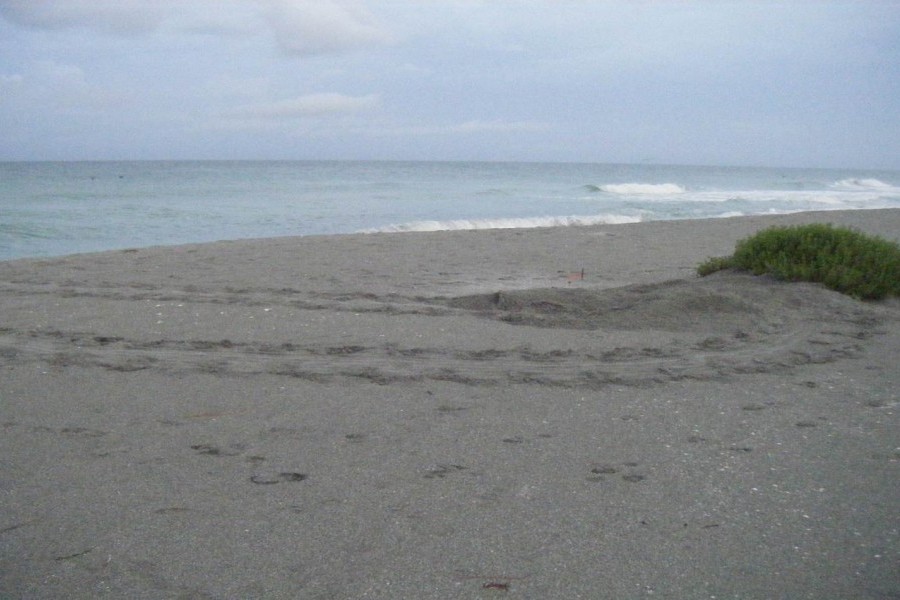Turtle nesting breaks record midway through season
Just two months into sea turtle nesting season, Mote Marine Laboratory scientists are happy to announce a record-breaking number of nests along Mote-monitored beaches from Longboat Key through Venice. In addition, the first nests of the 2016 season are starting to hatch. The first nests of the season are also starting to hatch.
“We are excited to announce that we have broken the 35 year annual record for sea turtle nests along our area’s beaches with a total of 2,638 confirmed nests so far and we are only halfway through the nesting season,” said Kristen Mazzarella, senior biologist with Mote’s Sea Turtle Conservation and Research Program.
Mote’s Sea Turtle Patrol — a group of scientists, interns and volunteers who monitor local nesting beaches daily from May 1-Oct. 31 — report that this year's 2,638 nests have already surpassed the previous record, the entire season total from 2015, by 163 nests.
Longboat Key broke its record of 698 nests on Thursday, June 30 with 716 nests and Casey Key broke its record of 1,174 nests on Saturday, July 2 with 1,184 nests. Lido Beach (record of 98 nests in 2014) and Venice (record of 424 in 2012) aren't far behind their past local records. So far there have been 86 nests documented in Lido Beach and 383 nests in Venice.
The first nest to hatch on Mote-monitored beaches was found Sunday, June 26 on Venice beach.
This season marks year 35 of Mote's Sea Turtle Conservation and Research Program coordinating conservation of endangered sea turtles along 35 miles of Sarasota County beaches.
Mote’s multi-decade monitoring efforts provide data that resource managers can use to understand and protect sea turtle populations. Long-term data are particularly important because sea turtles are long-lived species. It takes about 30 years for hatchlings born on our beaches to return to nest as adults.
These all-time high records since the inception of Mote’s Sea Turtle Patrol 35-years ago signify the need for conservation support. Funding for supplies and operating costs will be in high demand to keep up with the highly successful nesting season.
Supplies needed to help during the 2016 turtle nesting season include:
- Black permanent markers from Sharpie
- 100-foot large measuring tapes with non-metal blades
- Latex gloves, medium size (for excavating hatched nests to document their contents)
- Rubber mallets (for pounding stakes into the sand to mark nests)
- Yellow paint, 5-gallon cans (for painting stakes to mark nests)
- WD-40 lubricant (1 gallon)
- AAA and AA batteries (for GPS and cameras used to document nests)
- Waterproof field notebooks (from “Rite in the Rain” brand)
- Wire cutters for making and disassembling protective cages
- Caging material for protecting nests from predators
- Wooden nest marking stakes 3/8”x1.5”x48” or 3/8”x1.5”x36” with point on end
During this busy nesting season, it is important to keep local beaches turtle-friendly.
Female sea turtles and their hatchlings find the water by heading toward the brightest horizon. On a natural beach, the ocean horizon is brighter than the shore. On a developed beach, light from waterfront properties can disorient sea turtles and draw them toward roads, drains, yards, swimming pools and other dangerous locations, exhausting the energy they need for reproduction and survival.
If you see sea turtle hatchlings travelling toward land instead of the ocean, please call Mote's sea turtle program at 941-388-4331 for instructions. If you call after hours, then Mote's automated message system will let you know what to do. Please listen to it carefully.
Here are other turtle-friendly tips:
Do:
- If you encounter a nesting turtle or hatchlings, remain quiet and observe from a distance.
- Shield or turn off outdoor lights that are visible on the beach from May through October.
- Close drapes after dark and stack beach furniture at the dune line or, ideally, remove it from the beach.
- Fill in holes that may entrap hatchlings on their way to the water.
Do Not:
- Approach nesting turtles or hatchlings, make noise or shine lights at turtles.
- Use flashlights or fishing lamps on the beach.
- Encourage a turtle to move while nesting or pick up hatchlings that have emerged and are heading for the water.
- Use fireworks on the beach.
